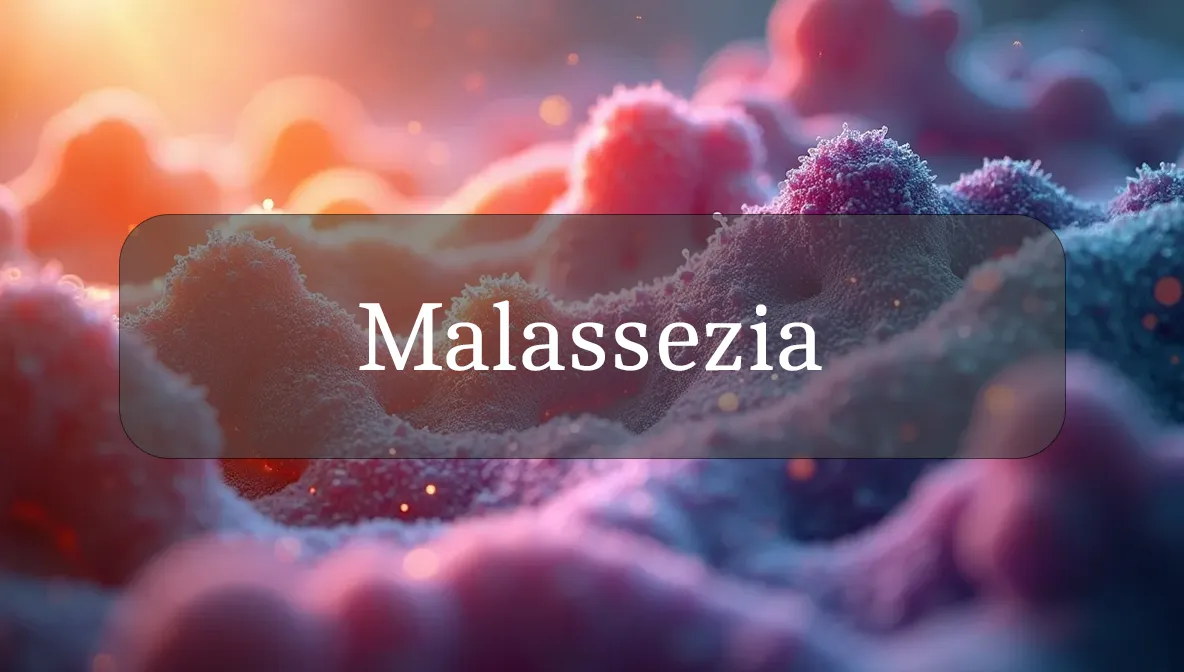Skin’s Fungal Neighbor for Balance and Wellness
Malassezia is like a quiet resident on your skin, a group of yeasts that are part of your natural microbiome but can cause issues when out of balance. These fungi thrive in oily areas and are key for health-conscious folks aiming to maintain clear, healthy skin. Understanding Malassezia can empower you to make choices that support your skin’s harmony and overall vitality. Let’s explore what Malassezia is, why it matters, and how you can manage its role for daily wellness!
Chemical Identity and Type
Malassezia is a genus of lipophilic (fat-loving) yeasts, single-celled fungi that belong to the phylum Basidiomycota. Common species include Malassezia furfur, Malassezia globosa, and Malassezia restricta. They lack fatty acid synthase genes, relying on sebum’s lipids (like oleic acid) for growth, and thrive in warm, humid, low-oxygen environments like hair follicles and sebaceous glands. Found primarily on the scalp, face, and upper trunk, Malassezia is a natural part of the skin microbiome. Think of it as a microbial gardener, feeding on your skin’s oils while influencing its ecosystem.
Biological Role and Benefits
Malassezia is a commensal organism that, when balanced, contributes to skin health with these benefits:
- Microbiome Balance: It competes with harmful microbes, helping maintain a diverse skin microbiome through colonization resistance.
- Sebum Regulation: By metabolizing sebum lipids, Malassezia produces fatty acids that contribute to the skin’s acidic pH, deterring pathogens.
- Immune Modulation: It interacts with the immune system, promoting a balanced inflammatory response to maintain skin homeostasis.
- Skin Protection: Its presence may help protect against more aggressive microbes by occupying ecological niches on the skin.
When in harmony, Malassezia supports a healthy skin barrier and microbial diversity, enhancing overall vitality.
Dietary or Natural Sources
Malassezia is a naturally occurring yeast on human skin, not sourced from food. However, you can support a balanced skin microbiome to keep Malassezia in check with these nutrient-rich choices:
- Probiotic-Rich Foods: Yogurt, kefir, and fermented foods (e.g., sauerkraut, kimchi) promote microbiome diversity, reducing Malassezia overgrowth.
- Omega-3-Rich Foods: Fatty fish, walnuts, and chia seeds reduce inflammation, supporting healthy sebum production and skin balance.
- Zinc-Rich Foods: Oysters, pumpkin seeds, and beef help regulate sebum and support skin immunity against fungal overgrowth.
- Antioxidant-Rich Foods: Berries, leafy greens, and green tea protect skin from oxidative stress, complementing Malassezia’s role in a healthy microbiome.
A balanced diet fosters a diverse microbiome, preventing Malassezia from becoming problematic.
Signs of Imbalance or Dysfunction
An overgrowth of Malassezia (often due to excess sebum, humidity, or microbiome disruption) may show up as:
- Dandruff (Seborrheic Dermatitis): Flaky, itchy scalp or facial skin with white or yellow scales, often on the scalp, eyebrows, or nasolabial folds.
- Pityriasis Versicolor: Discolored skin patches (hypo- or hyperpigmented) on the chest, back, or arms, caused by Malassezia metabolites like azelaic acid.
- Folliculitis: Itchy, red bumps or pustules around hair follicles, resembling acne, often on the upper trunk or face.
- Exacerbated Skin Conditions: Worsening of eczema, psoriasis, or rosacea, as Malassezia can trigger inflammation in sensitive skin.
- Systemic Infections (Rare): In immunocompromised individuals (e.g., neonates or IV catheter users), Malassezia can cause bloodstream infections.
These symptoms can have many causes, so consult a healthcare provider if they persist to explore skin or fungal issues.
Supporting Optimal Levels or Function
To maintain a balanced Malassezia population and promote skin health, try these evidence-based tips:
- Cleanse Gently: Use antifungal or mild shampoos with ingredients like ketoconazole, selenium sulfide, or zinc pyrithione to control Malassezia on the scalp or skin. Avoid harsh cleansers that disrupt the microbiome.
- Eat a Balanced Diet: Include probiotic foods, omega-3s, and zinc to support microbiome diversity and reduce inflammation. Limit high-sugar or high-fat diets, which may increase sebum production.
- Manage Sebum: Use non-comedogenic skincare to prevent excess oil buildup, reducing Malassezia’s food source. Avoid heavy oils or occlusive products.
- Keep Skin Dry: In humid climates, shower after sweating and wear breathable clothing to minimize warm, moist conditions that favor Malassezia growth.
- Protect Skin: Apply broad-spectrum sunscreen (SPF 30+) to prevent UV-induced inflammation, which can exacerbate Malassezia-related conditions.
Small, consistent habits foster a balanced skin microbiome, keeping Malassezia in its beneficial role.
Safety, Interactions, and Precautions
Malassezia is a natural part of the skin microbiome and safe when balanced, but consider these factors:
- Triggers for Overgrowth: Excess sebum (from hormonal changes, puberty, or oily skin), humidity, or weakened immunity (e.g., HIV, diabetes) can promote Malassezia overgrowth.
- Antifungal Resistance: Prolonged use of antifungals (e.g., ketoconazole) may lead to resistant Malassezia strains, reducing treatment efficacy. Use as directed by a healthcare provider.
- Skincare Products: Heavy oils (e.g., coconut oil) or occlusive moisturizers can feed Malassezia, worsening conditions like seborrheic dermatitis. Choose lightweight, non-comedogenic products.
- Rare Infections: In hospital settings, Malassezia (e.g., M. furfur) can contaminate IV lipids, causing infections in vulnerable patients. Proper hygiene and monitoring reduce risk.
Maintaining Malassezia balance involves gentle skincare, a healthy diet, and environmental awareness.
Fun Fact
Did you know Malassezia is so picky it can’t make its own fats? It relies entirely on your skin’s sebum for survival, making it one of the most specialized microbes in your microbiome!
Citations
- National Institutes of Health (NIH): Malassezia and Skin Microbiome.
- Mayo Clinic: Seborrheic Dermatitis and Pityriasis Versicolor.
- Cleveland Clinic: Nutrition and Skin Health.
- World Health Organization (WHO): Diet and Skin Wellness Guidelines.
- USDA: Dietary Guidelines for Americans – Nutrient-Dense Diets.

